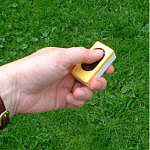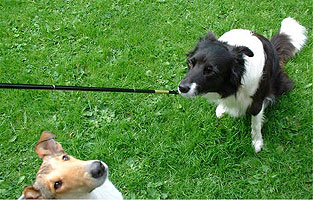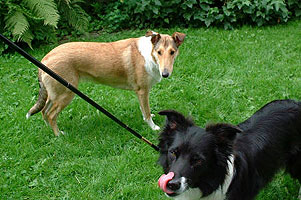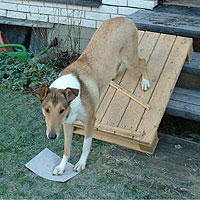| Back to main page |
 |
| The Art of Clicker Training | Ever heard the word "clicker" or "clicker-training" and wonder what makes it "click" for some dog trainers? Well, here's a picture of what a clicker looks like. It's a small plastic toy with a metal piece in it that makes a distinct clicking noise when you press it. The clicker is a tool that is used by trainers to enable them to tell the dog exactly when it did something to earn a reward. The reward, which might be a ballgame or savoury treats etc. (whatever the dog is willing to work hard to get), should always follow the clicking noise.
A lot of dog owners use the clicker when interacting with their dog, but that doesn't mean they are clicker-training per se. The definition of clicker-training is "...the use of operant conditioning based on positive reinforcement with the systematic use of a conditioned reinforcer" (Cecilie KÝste & Morten Egtvedt: "Klikkertrening for din hund", Canis forlag 2001). Clicker-training is more than just the presence of a clicker =the conditioned reinforcer. Clicker-training is also "operant conditioning based on positive reinforcement". In other words: As far as possible the dog is encouraged to find out on its own what behaviour pays off: No help in the form of pulling, pushing, showing or the use of correction or force. The sound of the clicker followed by the reward informs the dog exactly what he needs to know. The absence of reward (nothing happens) tells the dog when its actions won't pay off and therefore are no point in repeating. |
 Clicker-trainers use as little help as possible during the learning process, but one useful aid is the target. This can be a stick, like you see in this picture. The dog is being taught with the help of shaping to touch the stick with its nose or paw. Then the target can be used when shaping exercises like "crawling", "go-outs" or "heel", or tricks like "open and empty the letter box" or "turn on the light". This is a fun way of training your dog! Clicker-trainers use as little help as possible during the learning process, but one useful aid is the target. This can be a stick, like you see in this picture. The dog is being taught with the help of shaping to touch the stick with its nose or paw. Then the target can be used when shaping exercises like "crawling", "go-outs" or "heel", or tricks like "open and empty the letter box" or "turn on the light". This is a fun way of training your dog!
Clicker-training as a learning method has many advantages. All dogs are receptive to clicker-training. In clicker-training you concentrate on rewarding the behaviour you want rather than correcting or punishing what you don't want. The result are dogs that aren't afraid of making mistakes: They're inventive and resourceful and clever at showing initiative. The clicker-trained dog is used to discover for himself how to make his trainer click, and this makes him good at solving problems. A clicker-trained dog will easier be able to generalise what he has learned to new situations. I don't think I'm much mistaken if I say that clicker-trained dogs use every inch of their brain and therefore comes out as more intelligent! And last but not least: Clicker-trained dogs are very happy work-aholics! |
 Lotta has just heard the sound of the clicker. It's quite obvious she knows the meaning of the sound: Her long, pink tongue and alert face gives away the fact that her expectations are running high: She prepares herself for the juicy titbit of turkey sausage she just won... Notice that I haven't shown her that I've got treats for her. The goodies are kept out of view. In other words: It's not her nose or eyes that tell her reward is coming, but the sound of the clicker. It's best if the reward is not visible to the dog while training. Clicker-training is not about being bribed to perform, but about being rewarded for a well done exercise... And another thing: In this picture a second dog is standing close by. When training a dog you usually make sure other clicker-trained dogs don't stay too close, or they'll think they're being clicked as well. In this case I chose to reward both dogs even though I was only training one of them. Lotta has just heard the sound of the clicker. It's quite obvious she knows the meaning of the sound: Her long, pink tongue and alert face gives away the fact that her expectations are running high: She prepares herself for the juicy titbit of turkey sausage she just won... Notice that I haven't shown her that I've got treats for her. The goodies are kept out of view. In other words: It's not her nose or eyes that tell her reward is coming, but the sound of the clicker. It's best if the reward is not visible to the dog while training. Clicker-training is not about being bribed to perform, but about being rewarded for a well done exercise... And another thing: In this picture a second dog is standing close by. When training a dog you usually make sure other clicker-trained dogs don't stay too close, or they'll think they're being clicked as well. In this case I chose to reward both dogs even though I was only training one of them.
|
 Here the target is a piece of cardboard. I have taught Sanni to touch the target with her paws. Among other things I use the piece of cardboard when teaching her "go-outs". Here the target is used to teach the dog to walk down the A-frame in agility. Here the target is a piece of cardboard. I have taught Sanni to touch the target with her paws. Among other things I use the piece of cardboard when teaching her "go-outs". Here the target is used to teach the dog to walk down the A-frame in agility.
The art of clicker-training has given training a whole new meaning to me. Now both I and the dogs think training is both challenging and great fun! It's almost a religious experience watching a dog in just a few days turn into an enthusisastic work-aholic... I'm almost tempted to believe clicker-training is something of a miracle. But this learning method is far from supernatural: It's based on scientifically proved learning principles. |
| If you think clicker-training might be something for you and your dog or you would like to know more about what it's all about, then I can recommend a couple of books: "Don't Shoot the Dog" by Karen Pryor and "Clicker-Training for Obedience" by Morgan Spector; both are being published by Karen Pryor at Sunshine Books (see "links" at the main page). If you have the opportunity, attend a clicker-class or get together with people who know how to clicker-train. Clicker-training is not hard to do, but you need to take the time to adjust to a new way of thinking. If you want full payment of all the advantages clicker-training offers you it's important you don't mix it up with other methods. Are you game for a new challenge? |